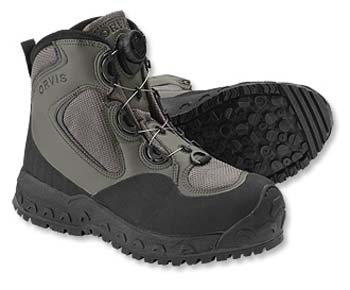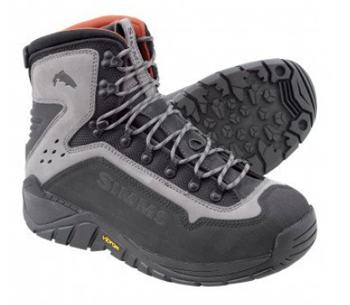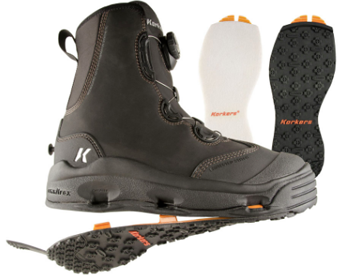By Skip Clement
[dropcap]F[/dropcap]ootwear – you’ve got to go to the store and try a pair on – walk the floor with them. However, that test drive is not going to tell you how they’re going to feel a few outings into them, especially if they’re wading boots and you’re 2,000 miles from the complaint desk.
However, buying a pair of wade boots is not much different than buying a pair of women’s Jimmy Choo Lang Sandals for $800 or men’s Ferragamo Calfskin Loafers for $500. It’s a little like a crap shoot.
Where to test drive wading boots?
A “good” fly shop, even in Florida or a coastal coordinate shop in Oregon is the best bet because they’ll always have a top of the line brand, like Simms and a great second-tier brand, like Redington. If they do not have your size – even brand, they’ll usually be able to get it in faster than you could and at no expense to you.
Another source for “show me the shoe” would be a big box outdoor store, but it would be hard to vouch for their wade boot knowledge or quickly doing anything beyond headquarter protocol.
Orvis has stand-alone stores with a fly shop integrated into them. They have their brand of wade shoes, as well as everything else. Orvis’ brand wade shoe selection is a mirror of what you’ll find in the better, independent fly shops – top of the line and lines of wade shoes below that. Contrary to popular belief, Orvis brands are not only competitively priced, excellent quality, and its guarantee pound-sterling.
One pair of wading boots is “In a League of Their Own,” Korkers. They have interchangeable soles, felt, rubber and a system for studs. Korkers’ initial product offering sole interchangeability was a problem – staying on, but that was yesterday ago. Then, there were complaints of the clip on wearing out too fast – primarily a pro guides complaint.
In 2018 and for the past few years, Korkers are close to being the most popular wade boot
“ . . . Now, I’m going into my third year with Korkers,” said Atlanta fly fishing guide Justin Powell. Adding, “It’s my only pair of wade shoes, and they get a lot of playing time.”
Chris Scalley’s, River Runs Through It – Chattahoochee River Guide Service likes the mid-priced Orvis Boa® Pivot Wading Boot and wears one pair every day. The Boa® is a dial-up stainless steel wire lacing system that snugs without fooling with fabric laces. Twist and go. “Benefit,” says Scalley, “it doesn’t wear out and has a screw in stud option.”
Being prejudicial
The best way to bias wade boot choices is to know what to look for, what questions to ask, and know what’s out there.
First and foremost is that they have to be a comfortable fit. Blisters and a good fishing experience are not compatible.
Think quick drainage – lugging around water is tiresome and annoying. Wading boots are not supposed to be waterproof or hold water; quite the opposite.
Buying wading boots is like purchasing polarized sunglasses – buy the best you can afford
Some wading boot manufacturers adapt their sizing by adding half or one size bigger than regular shoe measurements. Why? They are assuming the wearer will be using stocking foot chest or hip waders and additionally, socks. NOTE: To our knowledge Korkers, Simms, and Patagonia do not oversize their charts.
Online purchases of some off brands can be tricky. One, you’re not able to try them on, but you can send them back – a pain in the arse. Does your foot size fall squarely into halves (8-1/2, 10-1/2)?
Some Asian manufacturers have a width problem because Asians, generally have narrower feet. If you have wide feet and the manufacturer does not mention “wide” as a selection – beware.
A wade shoe that leaves a little extra toe room in front is not a good reason for complaint
What you should never tolerate is your feet being squished. One, wade boots are going to shrink even more via wet/dry cycles. Two, too tight leads to a rapid breakdown of the shoe. Three, cutting off circulation is dangerous. Lastly, squished feet in any shoe get colder much, much faster.
Minor, too big to fit, issues can sometimes be resolved by adding insoles, but insoles are not going to last long at all.
Choosing soles
• Felt:
For many, felt is the best in-water sole, but it is finding less favor with more conservation-minded millennials. Felt is associated with being a transporter of harmful microbes – invasive species, and as such felt soles are banned in some states, provinces, and countries.
However, felt is rock clingy, somewhat algae impervious, and its softness provides some extra cushioning
• Rubber
Initially, rubber soles got a deserved bad rap: too ridged, poor gripping anywhere, and got likened to steel mill worker shoes. Today, that’s not true. Many rubber “substance” soles are very rock-grip friendly, comfortable hiking – just generally having them on. The latter of course more of a compliment to the shoe design and construction itself.
• Metal Studs
Studs provide good gripping on any bottom found in fresh-coldwater riverine habitat. They are also like a fog horn or early warning device for nearby trouts. In New Zealand, they are the brunt of jokes.
Summary
Wade boots, those used on streams and walk-in negotiable rivers have to be comfortable in the water and on land; protect the most vulnerable part of their encapsulation, your feet, and ankles, be built to drain rapidly, and decent hiking boots. The latter is very defining.
NOTE: Metal studs and felt suck when trekking – only superior rubber soles are comfortable on long terra firma hike-ins.
Featured Image – public domain image.









